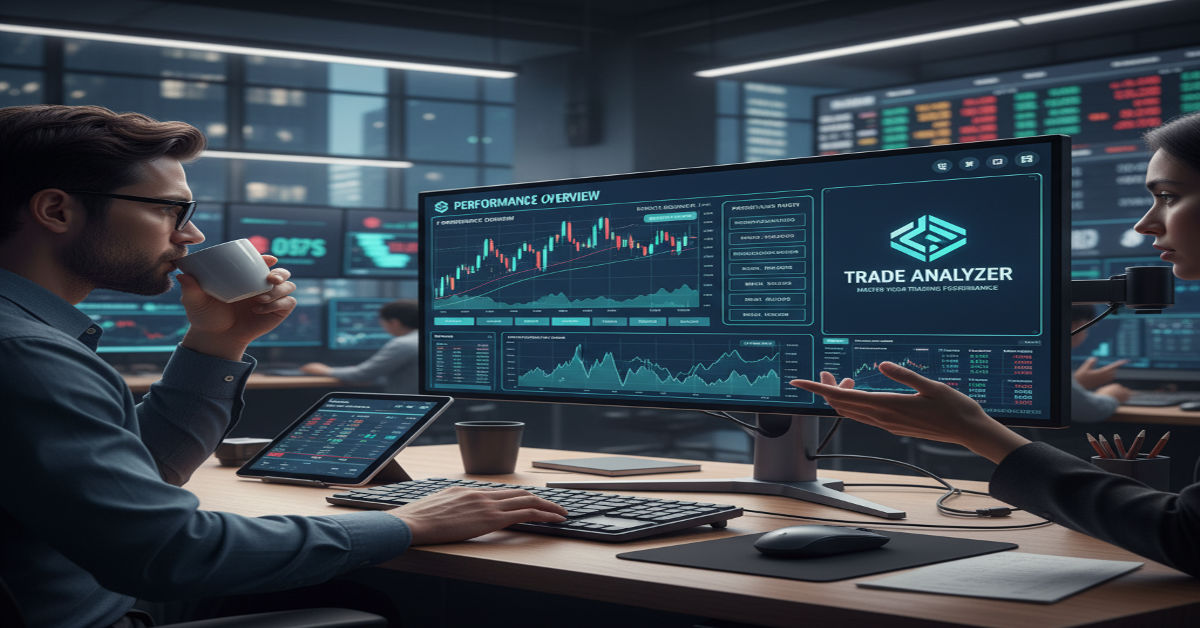Trading is not just about making the right moves it’s about understanding the patterns behind your performance. A trade analyzer is a tool that helps traders see beyond profits and losses by revealing why trades succeed or fail. In a world driven by data, this analytical approach transforms trading from guesswork into a measurable repeatable process. Whether you trade forex, stocks or crypto learning how to use a trade analyzer effectively can help you uncover trends, control risk and refine strategy for consistent success.
What Is a Trade Analyzer?
A trade analyzer is a performance-tracking system designed to record, measure and assess every trade you execute. It collects key parameters such as entry price, exit price, time, duration and trade size then converts them into analytical visuals and metrics. Unlike a basic trading journal, which focuses on note-taking, a trade analyzer highlights numerical insights—profit factor, win rate, drawdown, and risk-reward ratio.
It provides a factual foundation for reviewing decisions and identifying areas for improvement. Some platforms even combine analytics with AI to detect behavioural patterns or over-leveraging tendencies. Whether integrated into your brokerage or used as a standalone tool, its goal is to transform raw trade data into actionable insight.
Why Every Trader Needs One
Every successful trader relies on structured analysis. A trade analyzer adds objectivity to a process often influenced by emotions. It helps you:
- Recognize performance patterns.
- Detect emotional or impulsive trading.
- Track profitability and consistency.
- Fine-tune strategy based on evidence.
- Manage capital and risk better.
In essence, it turns subjective decision-making into data-driven management. Professional traders treat analytics as seriously as trade execution—because measurement drives improvement.
Key Metrics Tracked by a Trade Analyzer
A strong understanding of metrics allows traders to interpret results effectively. The trade analyzer automatically calculates the following indicators to assess overall performance.
| Metric | Description | Why It Matters |
| Win Rate (%) | Percentage of profitable trades | Measures trade accuracy but must be balanced with reward ratio |
| Risk-Reward Ratio | Average profit vs. average loss per trade | Ensures profits outweigh losses over time |
| Maximum Drawdown | Greatest account decline from peak to trough | Reveals worst-case risk exposure |
| Profit Factor | Total gains ÷ total losses | Indicates profitability sustainability |
| Expectancy | (Win rate × average win) − (Loss rate × average loss) | Predicts expected return per trade |
| Average Trade Duration | Time between entry and exit | Identifies if holding trades too long or exiting too early |
| Leverage Used | Exposure relative to equity | Helps avoid over-risking account |
These metrics form the foundation of your analytical dashboard. Reviewing them weekly provides a clear roadmap for incremental improvements in trading performance.
How a Trade Analyzer Impacts Risk Management
Risk management defines the survival of any trader. The trade analyzer makes it measurable by showing whether you’re adhering to proper risk limits and consistent sizing.
It highlights the correlation between leverage, drawdown and win rate—allowing you to balance potential returns with safety. For instance, you can see when high leverage correlates with deeper losses or when low-risk trades yield consistent results.
| Trade Size (% of Equity) | Avg Leverage | Win Rate | Max Drawdown | Comments |
| 1% | 10× | 60% | 5% | Ideal balance of safety and growth |
| 2% | 20× | 50% | 8% | Acceptable but should be monitored |
| 3% | 30× | 45% | 12% | Risk levels rising – review approach |
| 4%+ | 40×+ | 38% | 18% | Excessive drawdown – reduce exposure |
By monitoring such data, traders can maintain long-term sustainability instead of chasing short-term gains.
Selecting the Right Trade Analyzer Tool
When choosing a trade analyzer, ensure it integrates easily with your broker or trading platform. Key features to evaluate include:
- Automatic trade import to avoid manual errors.
- Flexible tagging and categorisation by instrument or strategy.
- Comprehensive reporting dashboards.
- Clear visualisations of performance trends.
- Mobile accessibility for on-the-go review.
- Data export for deeper custom analysis.
Select a platform that fits your workflow. Simplicity and accuracy matter more than extra features that complicate usability.
Integrating It into Your Trading Workflow
Integration determines how effectively a trade analyzer benefits you. Follow this workflow to maximise its impact:
- Connect your account: Sync trades automatically from your broker.
- Categorise trades: Label them by instrument, strategy, or time.
- Review daily: Record trade rationale and notes immediately after execution.
- Weekly analysis: Study metrics like win rate, expectancy and drawdown.
- Monthly optimization: Identify which instruments and sessions perform best.
- Adjust strategy: Apply insights from analytics to your next trades.
Consistency in analysis leads to consistency in results. The key is reviewing data regularly and making incremental refinements.
Real-World Example: Using a Trade Analyzer in Forex
Consider a forex trader who tracks 120 trades over three months using a trade analyzer. The summary reveals:
- Win rate: 48%
- Average profit: 38 pips
- Average loss: 75 pips
- Maximum drawdown: 12.4%
- Profit factor: 0.92
By identifying that losing trades were almost twice as large as winning ones, the trader refined stop-loss rules and target ratios. Three months later, the metrics improved to a profit factor of 1.22.
| Instrument | Trades | Win Rate | Avg Win | Avg Loss | Profit Factor | Key Insight |
| EUR/USD | 50 | 52% | 35 pips | 48 pips | 1.10 | Balanced performance |
| GBP/JPY | 30 | 40% | 55 pips | 95 pips | 0.78 | Large losses – pause trading |
| USD/JPY | 20 | 60% | 28 pips | 40 pips | 1.20 | Low volatility, steady gains |
| AUD/USD | 20 | 45% | 40 pips | 60 pips | 0.90 | Requires tighter stops |
This kind of instrument-specific analysis helps focus on markets that align with your strengths.
Common Mistakes and How to Avoid Them
Many traders misuse analytical tools. Typical errors include:
- Ignoring tagging or categorisation.
- Focusing on win rate while overlooking drawdown.
- Reviewing performance too infrequently.
- Neglecting the emotional side of trading.
- Failing to act on data insights.
Avoid these mistakes by setting structured review times and converting insights into actionable adjustments. Analytics without application is wasted potential.
Advanced Features to Look For
As your trading matures, advanced trade analyzer functions can provide a competitive edge. Seek tools that offer:
- Auto-synchronisation with brokers.
- Session or time-of-day analytics.
- AI-based performance suggestions.
- Visual dashboards with heat maps.
- Strategy comparison modules.
- Back-testing integrations.
| Trading Session | Trades | Win Rate | Avg Profit/Loss | Avg Duration | Key Takeaway |
| London Open | 40 | 55% | +18 pips | 3 hours | Most consistent session |
| New York Close | 25 | 35% | −10 pips | 5 hours | Consider avoiding low-liquidity hours |
| Asian Session | 15 | 60% | +22 pips | 2 hours | Short trades perform well |
| Post-News Trades | 20 | 30% | −45 pips | 6 hours | Avoid trading immediately after news |
These insights reveal not only when but how you trade most effectively.
Benefits for Beginners vs. Experienced Traders
For Beginners
- Encourages discipline and accountability.
- Reveals performance weaknesses early.
- Builds confidence through measurable progress.
- Reduces emotional decision-making.
For Experienced Traders
- Enables precise scaling of successful strategies.
- Provides deep performance segmentation.
- Tracks capital efficiency across instruments.
- Supports data-driven portfolio diversification.
Duration-Based Insights
Experienced traders often monitor holding times closely. The following table shows how trade duration affects outcomes.
| Duration | Trades | Win Rate | Avg Profit | Avg Loss | Insight |
| < 1 hour | 30 | 58% | +30 pips | −40 pips | Effective for scalping |
| 1–4 hours | 50 | 50% | +40 pips | −50 pips | Moderate success |
| 4–12 hrs | 25 | 42% | +50 pips | −80 pips | High risk, low reward |
| >12 hrs | 15 | 48% | +60 pips | −90 pips | Holding losers too long |
Both novice and advanced traders benefit by aligning trade duration with statistical success rates revealed by analyzers.
Conclusion & Call-to-Action
A trade analyzer bridges the gap between intuition and evidence. It empowers you to review, refine and repeat successful actions while minimizing costly mistakes. By applying its metrics, traders can master their emotional discipline, control risk exposure, and turn trading into a structured business.







